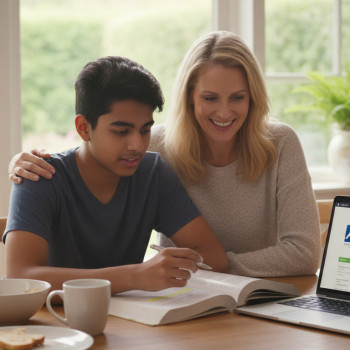Why This Matters: The Digital SAT and a World That Never Stops Scrolling
Preparing for the Digital SAT already asks a lot of you: resilient concentration, strategic practice, and a steady rhythm of review. Add in social media — designed to be sticky, attention-grabbing, and dopamine-friendly — and it’s no wonder many students feel like their study sessions are a game of whack-a-mole with notifications.
This post isn’t about fearmongering. It’s about understanding how social media actually affects the brain and study performance, and giving you practical, realistic steps to protect the time and mental space your SAT score needs to grow. I’ll also share examples, a simple daily plan, and ways Sparkl’s personalized tutoring and AI-driven insights can fit naturally into a distraction-resistant approach.
How Social Media Steals Study Time — Not Just Minutes, But Momentum
The illusion of “just one quick check”
We’ve all been there: you sit down to do a timed math section, tell yourself you’ll check Instagram for a second, and suddenly your 25-minute block becomes 40 minutes of split attention. The danger isn’t just the time lost to scrolling; it’s the interruption of flow. Every time you switch tasks, your brain needs time to reorient. That costs focus, accuracy, and confidence.
Attention fragmentation and what it does to memory
Studying isn’t passive. To retain concepts—like how to approach grid-in math problems or the structure of a passage-based reading question—you need deep processing. Social media pushes shallow processing: short bursts of sensory input that don’t give your brain a chance to consolidate learning into long-term memory. The result? You re-study the same weakness over and over without real improvement.
Real Consequences for Your SAT Score
Errors increase, speed suffers
On a test that rewards both accuracy and efficiency, fragmented attention translates into careless mistakes and slower pacing. Take reading sections: scanning a dense passage after a session of rapid, low-attention scrolling leaves you with a lower tolerance for sustained reading. That’s the exact opposite of what the SAT demands.
Practice quality matters more than quantity
You might be doing hours of practice, but if those hours are punctuated by social-media breaks, you’re getting qualitative shorthand — reduced comprehension, fewer “Aha!” moments, and less effective pattern-learning. Smart practice is focused practice. That’s where study plans that block distractions shine.
Why the Digital Environment Makes It Worse
Phones are double agents
When your practice is on a device (as with the Digital SAT), the line between study and distraction blurs. A browser window, an app switch, or a notification can instantly transport you out of Bluebook-style practice and into a feed that offers endless novelty. The device you need for practice becomes the tool that tempts you away.
Adaptive testing and fragile momentum
The Digital SAT is adaptive across sections; your performance shapes what comes next. Losing focus mid-section doesn’t just cost you one question — it can affect the adaptive path of the test and the types of questions you see. Staying mentally steady is therefore more important than ever.
Science-Backed Ways Social Media Cuts into Learning
- Switching costs: shifting tasks leads to a measurable drop in performance and takes time to recover.
- Dopamine-driven attention: social media uses reward loops that make returning to less immediately rewarding tasks (like problem-solving) harder.
- Reduced depth of processing: quick skims don’t form durable memories the way focused, elaborative practice does.
Practical, Compassionate Strategies to Protect Your Study Time
1. Design your physical and digital environment
Small changes set big boundaries. Put your phone in another room, use a simple alarm clock to time breaks, or install a website blocker during study periods. When your device is your study tool, log out of social apps or use separate profiles—one strictly for practice.
2. Use single-task study blocks (and make them feel manageable)
Try focused blocks like 40–50 minutes of practice with a 10–15 minute break, or 25/5 Pomodoro cycles for intense review bursts. The key is consistent, uninterrupted blocks that let you build momentum. Track your wins: finishing a full, timed section without checking your phone is a confidence builder.
3. Replace the habit loop
Social media is habitual. Replace the trigger-response with a study-friendly routine: when you feel the urge to check your feed, pause and do a quick breathing exercise or write a 2-sentence summary of what you just learned. Little rituals help rebuild the cue-reward cycle toward productive outcomes.
4. Make your practice active and reflective
Don’t just grind questions. After each practice set, spend 5–10 minutes analyzing mistakes: what pattern is emerging, which prompts confuse you, and how will you address it next time? This reflection is where deep learning happens — and it’s hard to do if you’re half-distracted by feeds.
5. Schedule social media like a subject
Yes, you can still enjoy social media. Treat it like another appointment: put it on the calendar for specific times, and stick to those windows. This removes the sneaky, fragmented checks that eat study time and trains you to enjoy feeds guilt-free during dedicated breaks.
A Sample Weekly Study Plan That Respects Focus (and Life)
This plan assumes about 8–12 hours of SAT study a week — enough for steady improvement without burnout. It balances content, strategy, and reflection, and protects big blocks of focus.
| Day | Session | Focus | Time |
|---|---|---|---|
| Monday | 1 | Timed Math Section (adaptive practice) | 50 min |
| Tuesday | 1 | Reading: Passage strategy + 2 passages | 50 min |
| Wednesday | 1 | Targeted review (analysis of mistakes, problem sets) | 40 min |
| Thursday | 1 | Writing & Language: grammar drills | 40 min |
| Friday | 1 | Full timed practice section (alternate Reading/Math) | 60 min |
| Saturday | 1 | Review weak areas + mini-diagnostic | 60–90 min |
| Sunday | Rest | Light review: 15–30 min, confidence-building exercises | 15–30 min |
How to Make Breaks Work (and Not Become Slide-to-Scroll Time)
Active, refreshing breaks
The best breaks reset your brain. Try a short walk, stretching, a healthy snack, or a quick sketch. If you want to use social media during breaks, set a hard timer and a one-thing rule — e.g., check messages only, no mindless scrolling through endless feeds.
Micro-habits to reduce urges
- Turn off nonessential notifications during study hours.
- Use grayscale mode on your phone to make apps visually less enticing.
- Keep a distraction log to notice patterns: what time of day do you most often check social media?
Tools and Techniques That Actually Help
Digital helpers that enforce real boundaries
Website blockers, focus apps, and the built-in screen-time controls on phones can be lifelines. But the tool is only as good as the intention behind it. Pair tools with clear rules: e.g., “No social apps during study blocks; allowed 30 minutes between 7–8 pm.”
Human accountability
Study partners, tutors, and coaches increase the cost of breaking promises to yourself. That’s why many students find structured tutoring helpful: regular check-ins create deadlines and momentum. If you’re feeling especially tempted to drift into feeds, a scheduled Sparkl tutoring session can be the nudge you need — Sparkl’s 1-on-1 guidance and tailored study plans help keep your practice focused and productive, and their expert tutors and AI-driven insights can identify patterns you might miss on your own.
How Tutors and Personalized Plans Fight Distraction
A generic study plan can’t account for the real-world traps that break concentration — family obligations, schoolwork, social life, or the siren call of social media. Personalized tutoring (like Sparkl’s) does three key things:
- Creates an individualized plan that matches your actual schedule and attention span.
- Provides immediate feedback on patterns in your practice so you don’t waste time on ineffective strategies.
- Offers accountability and coaching on study habits — not just content — so you build sustained focus over weeks, not days.
Example: Turning a Distracted Student into a Focused Scorer
Meet Maya (a composite student). She was doing five hours of “study” a week but her score wasn’t budging. Her problem was not motivation — it was fragmentation: she studied with her phone beside her and switched tabs constantly.
Step 1: She blocked social apps for study hours and created a 50/10 study-break rhythm. Step 2: She logged every distraction for two weeks and identified that she checked social media most after difficult math problems — a frustration loop. Step 3: With a Sparkl tutor, she replaced that pattern with a quick 2–3 minute problem-debrief ritual: write the mistake, try a parallel simpler problem, and then take a break if needed.
Result: In six weeks Maya’s practice accuracy improved, she took fewer careless errors, and her timing recovered. The difference was not more time — it was cleaner time.
Quick Checklist to Protect Your Next Study Session
- Phone out of reach or in another room.
- Browser tabs limited to study resources and practice platforms only.
- Clear goal for the session (e.g., “complete a timed reading section and write a 3-sentence mistake analysis”).
- Timer set for the session and for the break.
- Accountability: a study buddy, tutor session, or a recorded self-report to track progress.
What to Do If You Slip (and You Will)
We rarely become perfectly disciplined overnight. If you find yourself scrolling during study blocks, don’t spiral into guilt — treat it as data. Ask: when did it happen? What prompted it? Then adjust. Maybe your blocks need to be shorter, or perhaps you need to swap a difficult topic for an easier one to preserve momentum. Incremental adjustments beat dramatic guilt every time.
How to Measure Progress Beyond the Number on the Score Report
Scores matter, of course. But if you rely only on raw score changes, you can miss meaningful signs of improvement: fewer careless errors, better time distribution, stronger confidence on practice questions, and more effective review sessions. Track process metrics as well:
- Average number of distractions per session (aim down).
- Percentage of practice completed in uninterrupted blocks.
- Type-specific accuracy (e.g., algebra vs. geometry; main idea vs. inference).
These metrics tell a fuller story and are exactly the kind of insights a tailored tutor or platform can help you monitor — turning messy practice into reliable progress.
Final Thoughts: It’s Not About Surrendering Life — It’s About Choosing When You Live In It
The point is not to demonize social media. It’s a part of modern life and it’s okay to enjoy it. The trick is to choose when and how you engage so that the periods when you need deep focus — like when you’re preparing for the Digital SAT — are protected and purposeful.
Small, repeatable routines beat grand declarations. Start with a single change: one distraction-free 50-minute block each day. Build from there. If you want more hands-on structure, a personalized program like Sparkl’s tutoring can help you translate these ideas into a study plan that fits your real life — expert tutors, tailored study plans, and AI-driven feedback can all make your focused practice more efficient and less lonely.
Parting Practical Tips — Your One-Week Reset
- Day 1: Do a timed diagnostic and record distraction baseline.
- Day 2: Implement device boundaries (phone away, notifications off).
- Day 3: Use focused blocks with active reflection after each session.
- Day 4: Schedule one social media window and stick to it.
- Day 5: Try a session with a tutor or study buddy for accountability.
- Day 6: Review progress metrics and celebrate small wins.
- Day 7: Rest and mentally prepare for the next week — keep practice light.
Protecting your attention is one of the highest-return investments you can make for the Digital SAT. Treat focus like a muscle: train it with consistency, feed it with good habits, and give it the right kind of rest. Your score — and your confidence — will follow.
Ready to Try a Focused Session?
Pick a 50-minute block right now: move your phone, set a timer, open a single practice section, and commit. If you want personalized guidance, consider scheduling a Sparkl tutoring session — targeted coaching can shorten the path from distracted practice to steady improvement. Good luck, and study smart.















No Comments
Leave a comment Cancel